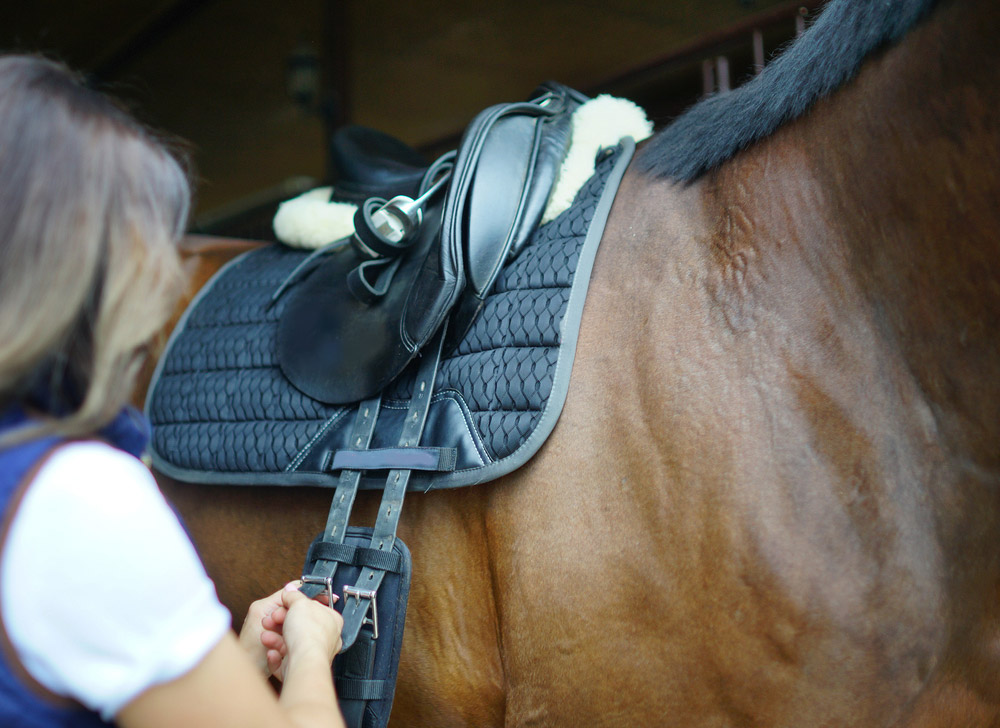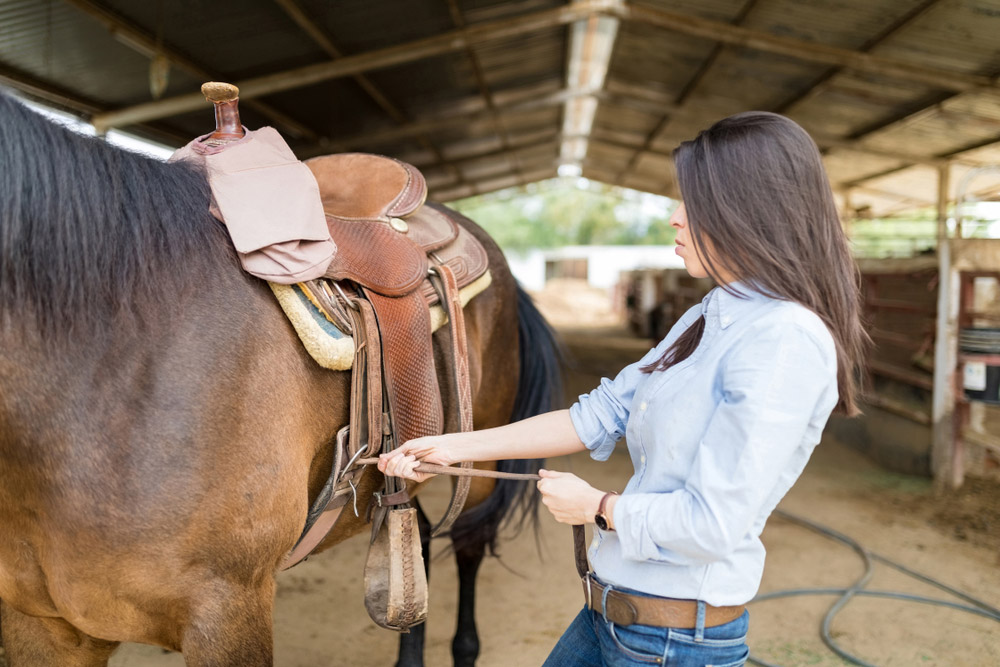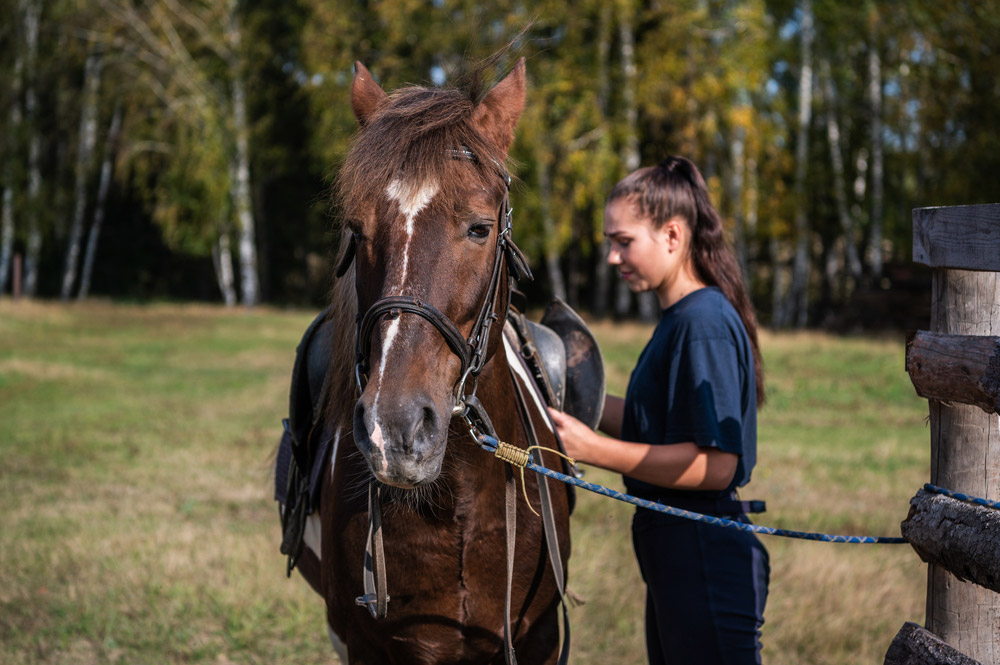A cinch helps to keep a saddle secure on an equine. Without this piece, the saddle will slip and fall off. Every rider should know how to cinch a saddle properly. This will provide enough safety and comfort for you and your horse. This detailed article reveals all the nuts and bolts on horse cinches and girths.
How to Cinch a Western Saddle
Tie your horse to put a saddle on the horse’s back. Place a saddle pad underneath if needed. When the saddle is set, grab a cinch. Stand on a side of the horse saddle and do the following.
- Place the saddle a bit forward the place where it should rest.
- Roll the stirrup over the saddle horn.
- Get the latigo strap into the D-ring on the tack. Pull up the cinch strap.
- Bring the cinch strap down and get the latigo end through the ring on the saddle. And then go back to the ring on the cinch.
- Loop the strap between these two rings until the excess strap is over.
- Get appropriate rigging: use a cinch buckle to secure the piece or make a cinch knot.
- Avoid any strap twists. Tighten the cinch but not overdo it. Check if you can place your fingers between the cinch and the horse. The tack should be set flat.

How to Attach Girth to English Saddle
Place a saddle on a horse. Put a saddle pad underneath if needed. Start with the ride side of the saddle. Here are the steps to follow:
- If there’s a girth strap on the bottom of the saddle pad, use it. Get one end of the girth through the strap. This will keep the saddle, a pad, and girth all in line.
- Use two outer billets (girth straps) and go through the buckles. Put the pieces on the first hole. Then you can change it.
- Go to the other side of the horse. Reach under and grab another end of the girth under the horse. Again, get through the saddle pad strap. Make sure the billets are over the girth. Repeat the rest of the actions mentioned before.
- Loosen or tighten the cinch size depending on your saddle and horse.
- Make sure the straps are secured firmly. The girth is flat on the horse. You can put your fingers under the belly.

Frequently Asked Questions
What Is the Difference Between a Girth and a Cinch?
A cinch and a girth are the same pieces of horse tack. The difference is that a girth is used in English riding and a cinch is used in Western riding.
What Are the Types of Horse Girths?
Saddle girths can be of two types – front cinches and back cinches. The front girth is used to fix a saddle on the horse’s back. While the back cinch is used with a Western saddle. It brings more protection while fixing the back of the saddle.
As for a cinch design, there are lots of options including:
- Straight. It’s a common type. The cinch can be made of various materials.
- Wide. It comes with a wide design in the middle of the gear. It brings extra support to the horse’s belly.
- Roper. It looks similar to the wide cinch but the roper is usually made with mohair. It helps to keep the saddle from slipping off.
- Contoured. It has a cut-back design that comes around the horse’s armpits. It’s made to enhance flexibility and free movements.

What Size Cinch Do I Need?
If you check a cinch size chart, you’ll see sizes come in 2-inch increments. Saddle cinches usually come 26 to 34 inches long. To get the right size, place a pad and a saddle on your horse. Take a tape measure or a piece of twine. Measure the girth area underneath your equine. Run between D-rings of the saddle. Subtract 16 inches to your result. As there should be 8 inches between the saddle ring and a cinch buckle ring on each side.
There’s an easy way to check if the cinch is right. Hand it down from the saddle. Check if the buckle is at the level of the middle of the horse’s cannon bone.
How to Measure a Girth for an English Saddle?
Before you start, tie up your horse to make it stay still.
Put a pad and a saddle on your horse. Grab a soft measuring tape. Run from a D-ring of the saddle and go underneath the belly. Reach another D-ring on the other side of the horse saddle. Subtract 16 inches to your result.
The girth size may vary from 18 to 56 inches. Depending on the horse height and disciplines you may need various tack. Girths of 18 to 32 inches long are great for dressage. While girths of 38-56 inches long are good for jumping.

How Tight Should a Western Saddle Cinch Be?
Make sure the cinch sits not too tight. There should be space to place your fingers between the gear and a horse. Tighten the cinch as you do with your belt.
How Do You Secure a Cinch?
When attaching the cinch, loop the strap so it won’t bother you. Put the strap through the cinch ring and pull it up. Bring the end back up and come through the D-ring at the top. Then bring the latigo back down through the cinch ring and tack the latigo layer underneath. All the straps have to be straight.
Loop the end to the top back again through the ring. To tight the loop, pull up the layer you just made. Cross the end over the straps and bring it up back through the ring. And then as you make a tie on your neck, get the end down through the loop you just created. Pull it until it’s snug. The excess leather you can bring it back up and place under the loop.
How Much Does a Girth Cost?
A horse girth costs from $20 to $500. The average price is $50. The price depends on the manufacturer and materials used.

Wrapping Up on Cinches
A cinch is a little piece but it does lots of work. It keeps your saddle tight to bring comfort for you and your horse. Some riders prefer to use both front and back cinches to add more stability. Different types of girths and cinches allow you to choose the best one.
Horses with sensitive skin like cinches with wool padding inside. Saddle pads may also help to bring more comfort. If you’re a rookie rider, ask your trainer which cinch size is best for your horse.
